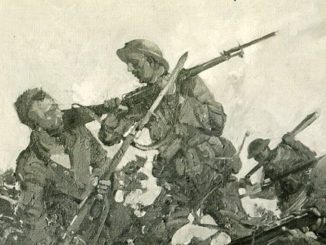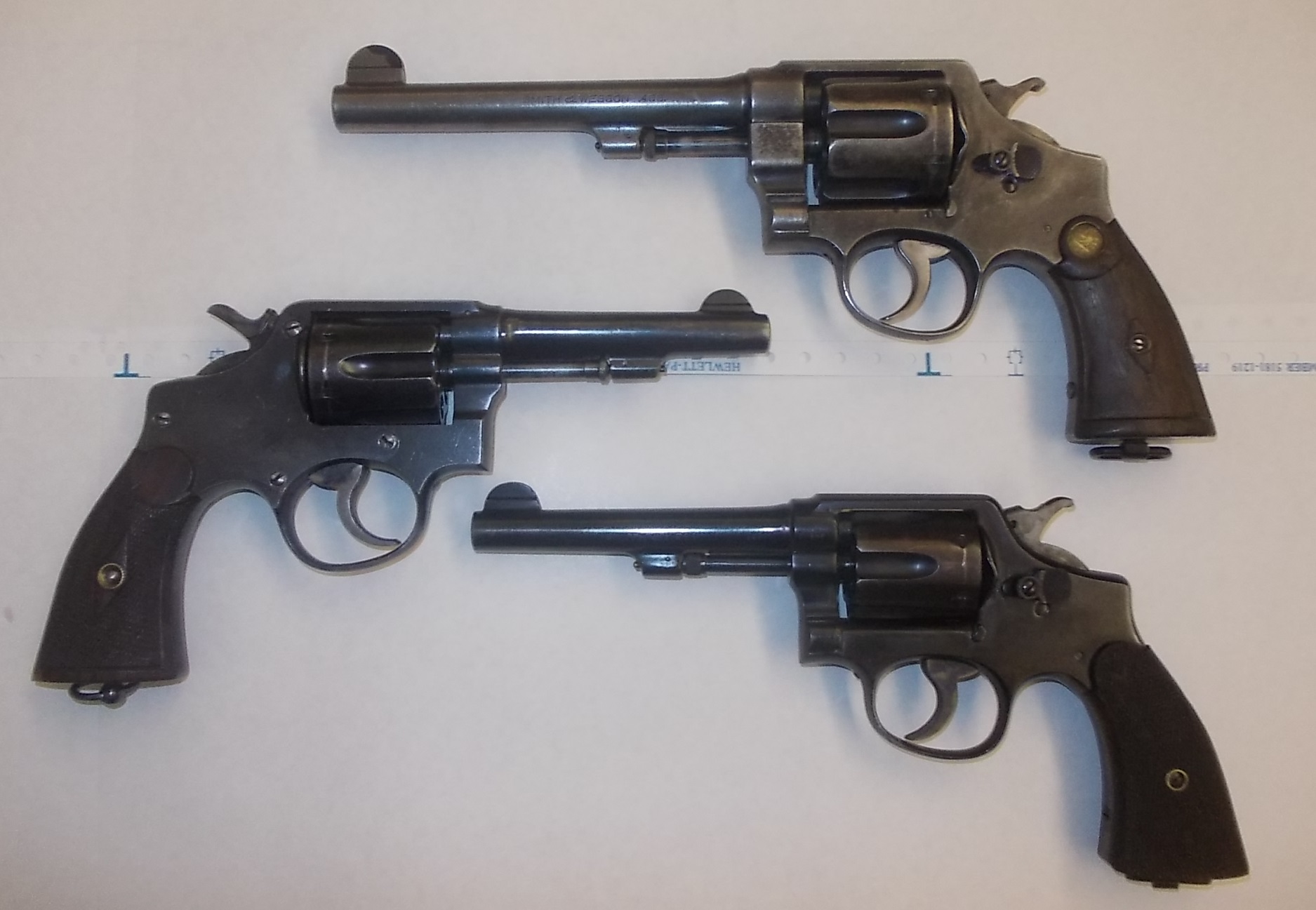The Iver Johnson company doesn’t get much respect or recognition these days, but they made a staggering number of generally very good, inexpensive handguns for many decades. The “cheap” image of the brand has largely prevented a significant collector appeal, and in turn a lack of good research or documentation. The exception to that trend is Bill Goforth, whom I have to believe ignored a great many snickers and jeers and spent a great deal of time and effort amassing a collection of Iver Johnson firearms and studiously researching their history. Mr. Goforth is sadly passed away now, but his knowledge lives on in the book he wrote, entitled Iver Johnson: Arms & Cycle Works Firearms 1871-1993. It is a heavily data-oriented volume, and an excellent resource for identifying and dating Iver Johnson revolvers (its coverage of long guns is minimal).
This was never destined to become a bestseller, but you can still get a copy on Amazon:




I happen to have an Iver Johnson revolver that belonged to my wife’s great-grandfather. It has seen a lot of hard use and came into our posession in non-firing condition. Will post a little more about it later.
I remember about 30 years ago you could generally find good condition IJs for well under one hundred dollars in the gun and pawn shops in the small towns of Arizona, Payson, Show Low etc. Antything in .22lr was generally way under $100.00. I still have and occaisionally shoot my Grandfather’s Iver Johnson Cycle Works single barrel 16ga shotgun. It was purchased sometime around (probably just before) the great depression. It is a well made shotgun. If my memory serves me correctly, Iver Johnson also pioneered the Transfer Bar safety on some of their revolvers, a concept that Ruger included in their Single Actions.
Iver Johnson produced also “Trigger Cocking Single Action Revolver”
http://peashooter85.tumblr.com/post/56832138659/the-iver-johnson-trigger-cocking-single-action
If memory serves me correctly, Iver Johnson also manufactured a lot of civilian M1 carbines during the period 1978-1992. There are still a lot of differing opinions regarding the general quality, fit and function ( ranging from excellent to downright dismissal ), and I suspect this is due partly to confusion over the name changes that have taken place over time ( Iver Johnson, Iver Johnson’s Arms, Iver Johnson’s Arms & Cycle Works ), as well as corresponding ownership changes that may have resulted in variations in production standards.
http://www.m1carbinesinc.com has a lot of useful historical, technical and background information on the M1 carbine, including some on the Iver Johnson products, if anyone is interested.
Believe they also made a couple of pistol versions of the M1 carbine, which looked neat but were likely of no practical use.
A couple of years ago I was in the local gun store and a guy came in with an Iver Johnson top break that was in 38 S&W. The guy wanted to know if a gunsmith could convert it to 357 Mag. He had heard that 38 (Spcl) could go in a 357 Mag, so it was logical (to him) that 357 Mag would go into a 38 (S&W, Spcl, whatever). The shop owner tried to educate him, but not too sure how well it went.
A book long needed
the ISBN number please
The ISBN number is 978-0-978-7086-0-3.
Fascinating! Iver Johnson (along with H&R and Merwin Hubert) filled a vital but derided role for decades – well-made, serviceable weapons that fit a working-class budget. Basically, Management carried engraved Smiths or Colts and drove Packards; Labor carried nickel-plated break-tops and either drove Model Ts or rode mules. So there is an element of class warfare to the undeserved “Saturday night special” reputation of Iver Johnsons.
Recently I was helping the probate lawyer sort out a deceased friend’s gun closet. My buddy had mentioned (and had shown me a few examples) that his father had picked up quite a few impulse-purchase cheap guns in the 50s and 60s. One that turned up was an apparently unfired blued breaktop outside-hammer IJ 5-shot .38 S&W with rubber grips. Not much snob appeal – looking at the internet, it’s worth less than $200 despite clean bore and lack of rust/ pitting – but it’s a good, solid, very ergonomic pistol that would do anything the earlier Smith breaktops it was patterned after, for half the retail price, while being safe to carry with a round under the hammer… which the Smiths weren’t. And while the breaktop Smiths were history by the turn of the century the Iver Johnsons were made until at least the early 1970s.
Iver J also made some really interesting solid-frame revolvers. The Shattuck Pattern .32s and .38s (based on an earlier spur-trigger rimfire single-action made by a company Iver Johnson bought) was the first solid-frame double-action revolver with a swing-out cylinder, predating Colt by at least 15 years. It was a neat design – the cylinder rod pivoted out from the muzzle end, bringing the cylinder out of the frame on the right side, and the user shucked the cylinder forward to empty the fired cases. It’s a great mystery why this nifty design didn’t see a belt-carry 6-shot .44 version… probably because “everyone knew” that IJs were cheap junk carried by poor people who couldn’t afford anything better.
By all accounts, the Iver Johnson copies of the Webley Bulldog 5-shot pocket revolvers in a variety of short .44 and .45 rounds were much, much better than the Belgian and Spanish copies of the era and (heresy!) may have been just as good (perhaps not quite as well polished) as the British originals. I’d love to see one of the Cowboy Shooting Sports companies come out with a transfer-bar Bulldog… in terms of sheer numbers there were far more British, Spanish, Belgian and American Bulldogs in the Wild West (not to mention the Wild East and Wild South) in the 80s and 90s than Peacemakers or Schofields.
On the M1 carbines… the IJ versions were actually quite well made, and had a degree of parts interchageability with the MILSPEC guns. The underserved bad rap comes from (a) the general reputation of Iver Johnson guns and (b) confusion with the Universal carbine copies, which were not nearly as well-made or reliable. (The Universal M1 carbine in .256 Winchester was a neat idea, if not very well executed.) The Enforcer carbine pistol, of which I’ve shot a couple, is a pretty neat early version of the CQB or PDW concept. (Again, the Universal version is crap.) It would be a good choice for “first through the door” or to grab when people are coming through the door, depending on your tactical situation. The problem is that carbine ball (and factory soft-points) are formulated specifically for a 16-inch barrel, and there is a huge un-burned powder blast when fired from a pistol. (Firing MILSPEC ball through a .30 Ruger Blackhawk is an experience you will not forget, which is why you should reload your fired carbine brass to .32-20 pistol specs – fantastic 50-yard metallic-chicken combination.)
Also – with both carbines and Enforcers – the 15 round magazines are rock-solid reliable, and the 30-round “bananas” are quirky. This is probably why the M2 never worked out very well. Some may argue but if I were carrying a M1 carbine in harm’s way I would take a dozen 15 rounders over six bananas.
One last note on Iver Johnson carbines… in the early 1950s when the US occupation forces were building the West German army, the venerable ERMA firm was looking to get back in the military-contract game and came up with a .22 Long Rifle training copy of the M1 carbine. These were imported from the 60s to some point in the 80s under the Iver Johnson name… not as reliable as a 10/22 but probably more accurate and definitely “cooler” (aside from the Iver Johnson stigma, of course.) These were available at every hardware store in the hundred-buck range, often admired and passed over. Of course, as soon as they went off the new-gun market everyone said “Damn, I meant to buy one of those” and currently a nice one is over $400. Don’t lose the 10-round magazine; replacement are around $50 if you can find one.
A wonderful and informative post, Jim — I learned a fair bit more about Iver Johnson and its product history — thanks!
“The Shattuck Pattern .32s and .38s (based on an earlier spur-trigger rimfire single-action made by a company Iver Johnson bought) was the first solid-frame double-action revolver with a swing-out cylinder, predating Colt by at least 15 years.”
It’s not true, there were not first solid-frame double-action revolver with a swing-out cylinder.
http://www.littlegun.info/arme%20americaine/artisan%20s/a%20shattuck%20hatfield%20gb.htm
States that Shattuck Pattern was patented in 1879, when
http://books.google.pl/books?id=T-Irz4qHwsQC&pg=PA20&lpg=PA20&dq=%22Winchester-Borchardt%22&source=bl&ots=-ZfQWBj3L5&sig=y52ZYVkB7ZW9mInXR-HLdko2eMM&hl=pl&sa=X&ei=QxRoUsyLFMW44ATKm4HQAw&ved=0CD0Q6AEwAg#v=onepage&q=%22Winchester-Borchardt%22&f=false
States that Winchester-Borchardt swing-out revolver were make in 1876.
Sorry, I didn’t read that Winchester-Borchardt was single action. Sorry, my fault.
I want to take the time to say “THANK YOU” to you for keeping my father’s passion alive. I am W.E. (William or Bill) Goforth’s daughter. Since my father’s passing in 2010, my mother and I have been in contact with many of people who my father helped with locating, fixing or just plain telling about Iver Johnson’s.
Again, I just want to thank you for the wonderful book review.
Holly Frank
My pleasure, Holly!
looking for info on a IJ 22 that I acquired recently. Found that info and learned about the product and history. Thank you.
The Book by Goforth on the Iver Johnson Handguns seemy to be really good. However does any one know of a book that has information on Iver Johnson Shotguns?
Ttying to find out when my gun was made .model 55a round 6 inch barrel H31722 22revolverwith owl on handle
1961 or 1962